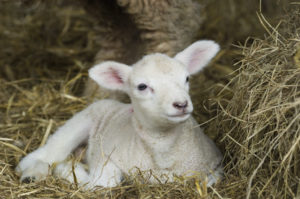Preparation is key for success, something which is well known by sheep farmers; poor preparation leads to chaos. Ensuring that staff are trained and understand the system is just as important as making sure that the environment is clean with adequate supplies of the essentials. Ewe condition and litter size are well-known details that are acted upon. Healthy ewes with good teeth, feet, and udders are more than capable of rearing twin lambs. It is ewes that have had prior issues lambing or previous udder problems which will need extra care; it is advised that ewes that have a history of problems should be recorded and culled.
Attention to ewes which are not the desired body condition score, carrying multiples or first time lambers is needed to minimise problems. Ewes which are overfit can have issues with the physical lambing itself, they may have large lambs which need assistance and tend to be more prone to prolapses. For those underfit, an eye is needed for the lambs – have they suckled? Does the ewe have enough milk? Can she support more than one lamb? First time lambers can be flightier; it is their first time in this environment, often the first time in the shed for a prolonged period and undergoing a stressful situation.

Lambing is a stressful period for all involved. For the lamb, this means going from a warmer environment to a potentially cold, wet, and muddy one. Ensuring they suckle essential colostrum quickly is critical for survival. Lambs require 50ml/kg (of birth weight) of colostrum within the first 2-6 hours. Within 24 hours, lambs should receive 200ml per kg (of birthweight), as a guide an optimum birthweight for twins is 4-5kg per lamb (AHDB Feeding the Ewe, 2017).
Being born in dirty environments can increase the risk of diseases as the first thing the lamb will ingest is bacteria or pathogens from faeces or dirty bedding, which will reduce the absorption of the antibodies in the colostrum. Specific to indoor lambers, clean pens will also benefit the ewe, particularly when it comes to foot health. Although this starts before
the lambing period; ensure those which are lame are managed accordingly to reduce the severity. If pens are wet and damp, bacteria and pathogens will thrive, which will increase the incidence of poor foot health having a knock-on effect on performance: dry matter intakes, milk yields, and therefore lamb health.
Ensure regular littering of pens is done to keep them dry, adding hydrated lime to both group and individual pens will also help. Good nutrition pre-lambing with quality rations can increase the quality of colostrum and lamb vigour. Similarly, when looking for a colostrum or milk replacer, review the ingredient list. Often, the smaller the ingredient list the better. The ingredients listed must be digestible to the lambs and the colostrum replacer should have colostrum at the top of the ticket.
Although out of our control, the weather is a key factor in a successful lambing. If the weather is wet, windy, and cold, lambing success is often reduced. Attention to detail and careful preparation is needed for a successful lambing in challenging weather conditions.
Top tips to consider:
• Outside ensure there is plenty of shelter to protect against the weather. If indoors, litter pens more regularly, wet weather will encourage damp bedding.
• Keep an eye on feed intakes, make sure both ewes and lambs are eating what is expected.
• Minimise rushing around, easier said than done but taking the time to
inspect animals is key to picking up issues and therefore impact on lifetime performance and farm profitability.
• Boost grass growth at spring turnout with an early application of fertiliser, subject to ground conditions.
For more information on our ewe & lamb feeds, please call 0800 756 2787 or click HERE.
by Beth Howells, Technical Advisor, NWF Agriculture.
